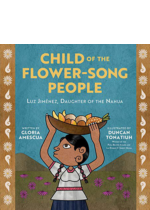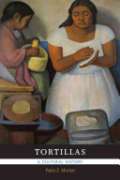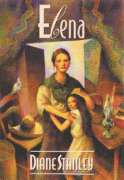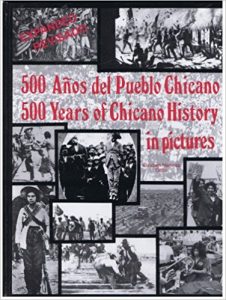A fascinating picture book biography of Benito Juárez, president of Mexico during its tumultuous time of Liberal Reform.
Mexican history
Child Of The Flower-Song People: Luz Jiménez, Daughter Of The Nahua

As a young Nahua girl in Mexico during the early 1900s, Luz learned how to grind corn in a metate, to twist yarn with her toes, and to weave on a loom. By the fire at night, she listened to stories of her community’s joys, suffering, and survival, and wove them into her heart. But when the Mexican Revolution came to her village, Luz and her family were forced to flee and start a new life. In Mexico City, Luz became a model for painters, sculptors, and photographers such as Diego Rivera, Jean Charlot, and Tina Modotti. These artists were interested in showing the true face of Mexico and not a European version. Through her work, Luz found a way to preserve her people’s culture by sharing her native language, stories, and traditions. Soon, scholars came to learn from her
Child of the Flower-Song People is a WOW Recommends: Book of the Month for May 2022.
Tortillas

“The ordinary tortilla was an extraordinary bond between the human and divine. . . . From birthdays to religious ceremonies, the people of Mesoamerica commemorated important events with tortillas. One Maya tribe even buried their dead with tortillas so that the dogs eaten as dinner during life would not bite the deceased in revenge.”–from Tortillas: A Cultural History For centuries tortillas have remained a staple of the Mexican diet, but the rich significance of this unleavened flatbread stretches far beyond food. Today the tortilla crosses cultures and borders as part of an international network of people, customs, and culinary traditions. In this entertaining and informative account Paula E. Morton surveys the history of the tortilla from its roots in ancient Mesoamerica to the cross-cultural global tortilla. Morton tells the story of tortillas and the people who make and eat them–from the Mexican woman rolling the mano over the metate to grind corn, to the enormous wheat tortillas made in northern Mexico, to twenty-first-century elaborations like the stuffed burrito. This study–the first to extensively present the tortilla’s history, symbolism, and impact–shows how the tortilla has changed our understanding of home cooking, industrialized food, healthy cuisine, and the people who live across borders.
Colors Of Mexico
Explores the different colors found in Mexico’s nature and history.
Elena

A Mexican American girl recounts how her mother moved the family to America during the Mexican Revolution.
500 Anos del Pueblo Chicano/500 Years of Chicano History: In Pictures
 This bilingual pictorial history depicts the Mexican American/Chicano people from their origins 500 years ago with Columbus’ “discovery” and the invasions of the New World, to their struggles for social justice today. Over 800 photographs with brief explanatory texts tell the story of how Mexicans came to what is now the U.S. well before the Pilgrims and after the U.S. war of 1846-48, were made strangers in their own land. Elizabeth Martinez, author of books and articles on social movements, presents a vivid record of the life, culture, and collective struggles by farmworkers, miners, students, factory workers, women’s organizations, noted leaders, immigrants, and artists across the country. The faces of weathered workers, militant youth and beautiful children alternate with victims of lynchings and bloody repression to create a work of both pain and celebration. This updated edition should be of special interest, given today’s emphasis on multiculturalism, to teachers and students as well as the general public. The publisher, the SouthWest Organizing Project, is a community-based organization nationally known for its work on racial, social, and economic justice issues. Order from Southwest Community Resources, 211 10th St., SW, Albuquerque, NM 87102, 505-247-8832.
This bilingual pictorial history depicts the Mexican American/Chicano people from their origins 500 years ago with Columbus’ “discovery” and the invasions of the New World, to their struggles for social justice today. Over 800 photographs with brief explanatory texts tell the story of how Mexicans came to what is now the U.S. well before the Pilgrims and after the U.S. war of 1846-48, were made strangers in their own land. Elizabeth Martinez, author of books and articles on social movements, presents a vivid record of the life, culture, and collective struggles by farmworkers, miners, students, factory workers, women’s organizations, noted leaders, immigrants, and artists across the country. The faces of weathered workers, militant youth and beautiful children alternate with victims of lynchings and bloody repression to create a work of both pain and celebration. This updated edition should be of special interest, given today’s emphasis on multiculturalism, to teachers and students as well as the general public. The publisher, the SouthWest Organizing Project, is a community-based organization nationally known for its work on racial, social, and economic justice issues. Order from Southwest Community Resources, 211 10th St., SW, Albuquerque, NM 87102, 505-247-8832.
